The best free resource planning software gives businesses a clear understanding of available resources, such as employees, equipment, and time. These providers offer key features like document management, task reminders, and data viewing options. Using the right resource planning tool increases efficiency, improves collaboration, and offers real-time data insights. In our guide, we evaluate several platforms based on use cases, pricing, and features.
- monday.com: Best Overall Resource Planning Software
- Wrike: Best for Usability & Artificial Intelligence (AI)
- ClickUp: Best for Remote Team Collaboration
- Asana: Best for Multi-project Workflow Management
- Smartsheet: Best for Project Organization Spreadsheets
- Airtable: Best for Data Tracking
One app to replace them all: Get everyone working in a single platform designed to manage any type of work with ClickUp. |

|
Best Free Resource Planning Software at a Glance
Free Resource Planning Software | Free Plan Features | Learn More | |
|---|---|---|---|
4.64 out of 5 | $10 |
| |
$9.80 |
| ||
4.41 out of 5 | $10 |
| |
4.40 out of 5 | $13.49 |
| |
4.39 out of 5 | $12 |
| |
4.10 out of 5 | $24 |
| |
monday.com: Best Overall Free Resource Planning Software

What We Liked
- Offers multi-level permissions
- Includes dashboard email notifications
- Shows work performance insights
Where It Falls Behind
- Free plan file storage is limited to 500MB
- Premium integrations only unlock under the Enterprise plan
- Free and basic plans don’t have calendar viewing
monday.com Monthly Pricing Choose annual billing and save up to 18% (per Seat)
- Free: Free for two seats, three boards, unlimited documents, 200-plus templates, and eight column types
- Basic: $10 for unlimited seats and items, 5GB file storage, one week activity logs, unlimited boards, and unlimited free viewers
- Standard: $12 for 20GB file storage, six months activity log, Zoom integration, 250 integration and automation actions, and up to five combined dashboards
- Pro: $24 for 100GB file storage, one year activity log, private boards and docs, time tracking, and up to 10 combined dashboards
- Enterprise: Custom pricing for advanced reporting and analytics, up to 5 years file storage, 1TB of file storage, and up to 50 combined dashboards
monday.com is our top free resource planning tool because it’s an all-around project management software customizable to suit business operations. As an open platform, you can select modules and integrations for workflow automation and choose widgets for creating a fully functional dashboard. It’s also one of the few project management tools with built-in time-tracking capabilities at no extra charge.
The time-tracking feature lets you see your team’s time spent on each task. Make smarter decisions about your pricing, project timelines, and team schedule based on time-tracking information. While monday.com is excellent for collaboration, its paid plans don’t allow single-user accounts or two-user subscriptions. All monday.com paid plans have a three-seat minimum. Try Airtable because it has no minimum user requirement, and all period plans allow unlimited users. Read our Airtable vs monday.com article for a detailed comparison.
monday.com Features
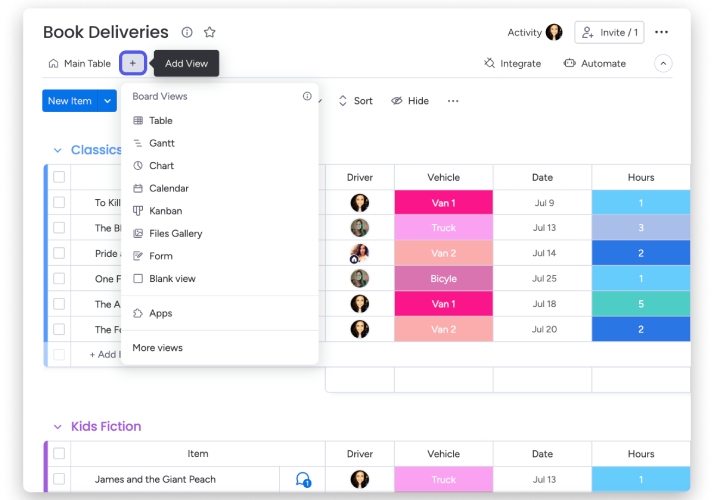
Break projects down into tasks, assign team leads, and add board views easily.
(Source monday.com)
- Multiple board views: Visualize your information differently by choosing from monday.com’s various board views. Add a board view by clicking the “+” icon below the board title.
- Workload widgets: Use widgets to visualize the amount of work each team member has and their upcoming deadlines.
- Advanced board filters: This feature lets users filter information on boards to narrow down project details and statuses. Use filters to find specifics, such as late deadlines and over-budget items.
Wrike: Best for Usability & Artificial Intelligence

What We Liked
- The free plan comes with unlimited users
- All plans support eight languages
- Extensive work intelligence features like smart replies and quick reactions
Where It Falls Behind
- Advanced analytics and data visualizations are only available on the highest enterprise plan
- Free plan’s workflow automation is limited to use case project templates
- Lacks a built-in chat option and relies on third-party integrations like Slack
Wrike Monthly Pricing (per User)
- Free: Free for unlimited users, eight language support, 2GB storage, task and subtask management, and email notifications and integrations
- Team: $9.80 for two to 25 users, 50 automations, personal work schedules, custom fields, workflows and statuses, and dynamic Gantt chart
- Business: $24.80 for five to 200 users, 200 automations, 5GB storage, branded workspace, project portfolio management, and real-time reports
- Enterprise: Custom pricing for five to unlimited users, 10GB storage, 1,000 automations, tableau integration, business intelligence application programming interface (API), and advanced user access controls
- Pinnacle: Custom pricing for 15GB storage, 1,500 automations, advanced analytics and data visualizations, performance dashboard, job roles, and advanced proofing
Compared to other free resource planning tools, Wrike is our top pick when it comes to user-friendliness and design interface. All documents and communications related to a project are linked within the project portfolio, making it simple for members to locate files and conversations and get up to speed on updates. Wrike’s Work Intelligence uses machine learning and recommends activities, accelerating routine tasks and streamlining workflows.
Wrike’s machine learning features identify historical patterns and transform your rough notes into task lists for higher operational productivity. Despite its ease of use and AI capabilities, Wrike lacks a built-in chat option. While it allows task comments for coordination, users use third-party integrations like Wrike for Hangouts Chat to communicate efficiently. For internal messaging capabilities, try Asana. You can send messages directly to other users within the Asana app.
Wrike Features

Wrike’s automated task prioritization recommends and reorders your workflow based on urgency. (Source: Wrike)
- Role assignment: Gain control over who has access to your tasks and assign custom roles to team members on your account. Keep everyone accountable and track who is handling each assignment.
- Budgeting tools: Track expenses, set fund limits, and monitor budget utilization using monday.com’s ready-to-use budget tracker template. Customize templates based on your needs and easily spot the difference between your budget and actual expenditure.
- Gantt charts: Get an overview of your project and quickly identify the status of each task. Plan using customizable templates and compare plans versus the actual progress of tasks over time.
ClickUp: Best for Remote Team Collaboration

Pros
- Offers white labeling
- Artificial intelligence (AI) compatibility
- 50-plus native integrations
Cons
- Interface can be complex for new users
- Limited storage in the free plan
- Short message service (SMS) for two-factor authentication (2FA) is only available in Business and Enterprise plans
ClickUp Monthly Pricing Choose annual billing and save up to 37% (per User)
- Free: Free for 100MB of storage, unlimited tasks, real-time chat, and native time tracking
- Unlimited: $10 for unlimited storage, guests with permissions, and agile reporting
- Business: $19 for unlimited teams, advanced dashboard features, and workload management
- Enterprise: Custom pricing for white labeling, team sharing for spaces, and live onboarding training
ClickUp is a popular project management tool featuring several collaboration tools, such as task assignment and reporting statuses. Streamline hybrid and remote team communication by using it to send and receive emails and chats or edit documents with colleagues. ClickUp’s customizable reports make it easy to generate tailored insights about your team’s performance. See each team member’s schedule and task, and use custom dashboards to track progress.
Give users access to essential updates, assign tasks, and update colleagues on the go using ClickUp’s comprehensive mobile app. Unfortunately, users on the free plan are limited to 100MB of storage. If you need more storage, check out Wrike. Its free plan includes 2GB of storage, unlimited users, and task and subtask management.
ClickUp Features
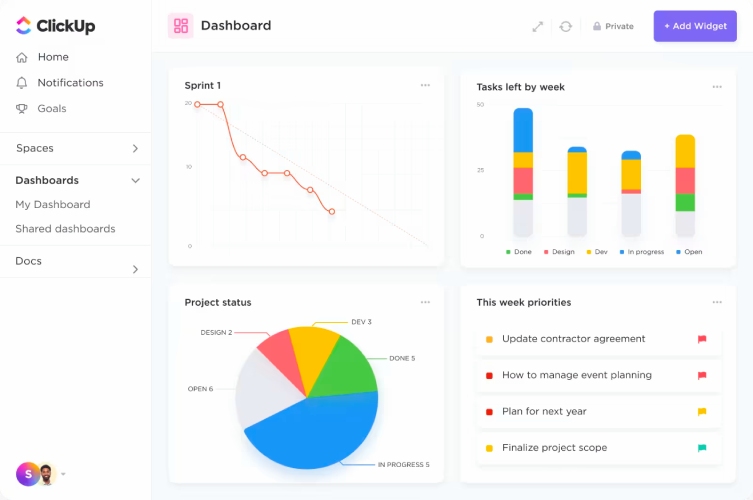
Visualize, track, plan, and view goals using ClickUp’s dashboard. (Source: ClickUp)
- Customizable tasks: Build a task management system by choosing from 35-plus ClickApps. Managers can create views in Space, Folder, or List to see tasks in the location. This is great for overseeing team and individual progress.
- Templates: Templates in the Template Center are available on all plans. The Center is a library with pre-made templates you’ve saved. Use templates for automation, statuses, and emails.
- Milestones: Visualize the significant milestones of a project and understand your team’s progress instantly. Milestones are available on all ClickUp plans, and the Free Forever plan comes with 10 uses. If you’ve opted for a paid plan, these have unlimited uses.
Asana: Best for Multi-project Workflow Management

What We Liked
- Base plan comes with time tracking with integrations
- Includes reporting across unlimited projects
- Free plan comes with unlimited file storage
Where It Falls Behind
- The free version is available for teams of up to 15 people
- Priority support is only available in the Enterprise plan
- There is no internally-hosted version of Asana
Asana Monthly Pricing (per User) Save up to $5.50 per user, monthly when you opt for the family plan
- Free: Free for unlimited tasks, projects, messages, activity logs, and file storage (1GB per file)
- Premium: $13.49 for timeline, workflow building, unlimited dashboards, advanced search, and custom fields
- Business: $30.49 for portfolios, custom rules builder, advanced reporting, time tracking, and lock custom fields
- Enterprise: Custom pricing for user provisioning and deprovisioning, data export and deletion, custom branding, and priority support
Use Asana if you’re looking for free resource planning software for efficiently managing multiple projects. Asana Portfolios allows users to monitor all initiatives in a single place. Set team priorities and track different projects using a single view. Easily update your team by sharing your portfolios with stakeholders and relevant parties and monitor the progress and status of critical initiatives.
Unfortunately, even with Asana’s robust project management tools for cross-functional teams, you can only assign one person to each task. If having one task owner will not suffice for shared tasks, give monday.com a try. It allows users to assign multiple team members as a task or item owner. You can continue adding as many people as necessary and assign an entire team to inputs under the People column.
Asana Features
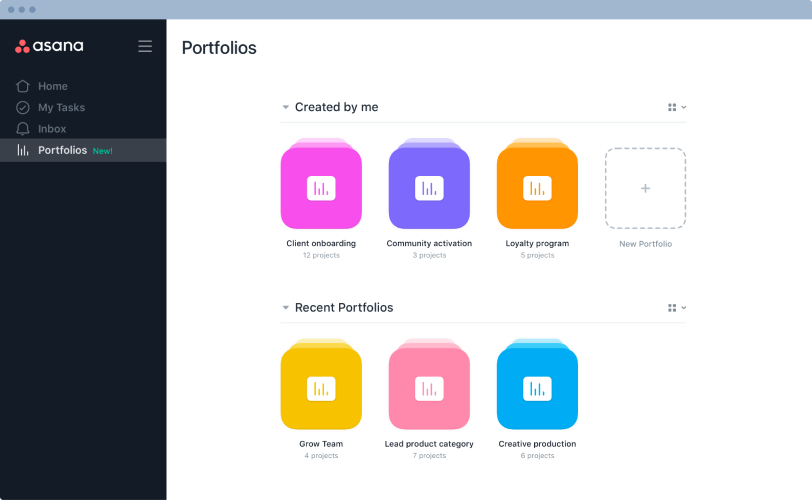
Organize multiple projects in a team portfolio for easy monitoring. (Source: Asana)
- Multi-language support: Teams worldwide use Asana to manage their work because it allows teams and clients to communicate using the most comfortable language. Asana currently supports English, Traditional Chinese, Russian, Dutch, Polish, Italian, Swedish, Korean, French, German, Portuguese, Spanish, and Japanese.
- Teams and collaborators: Organize and monitor projects by creating teams with shared conversations and group chats. Adjust privacy settings as needed and add team members as collaborators. This ensures everyone’s looped in and receives notifications on project-related updates.
- Teammate view: See what people have on their plate by viewing their assigned tasks. Easily switch between different teammates and see their dashboard and project reports.
Smartsheet: Best for Project Organization Spreadsheets

What We Liked
- Offers custom email domains
- DocuSign integration
- All plans feature cross-sheet formulas
Where It Falls Behind
- Only the highest plan has work insights
- Not all paid plans have unlimited editors
- Interface requires some familiarity with spreadsheets
Smartsheet Monthly Pricing Annual billing for paid plans start at $9 per user, monthly (per User)
- Free: Free for one user and up to two editors, two sheets, 100 automations, dashboards, and 50MB attachment storage
- Pro: $12 for up to 10 users and unlimited viewers, 250 automations, and 20GB attachment storage
- Business: $24 for at least three users and unlimited editors, document building, unlimited automations, and 1TB attachment storage
- Enterprise: Custom pricing for directory integration and account discovery, work insights, unlimited attachment storage, and domain validation
Smartsheet is the best free resource planning software focusing on spreadsheets, allowing efficient project organization and resource allocation. It features an extensive library of templates and customization tools that lets you apply your company color scheme and logo to your smartsheets. Its template gallery features 284 templates and template sets, including quantity-based earned value and individual task management templates.
Smartsheet uses a Kanban board—a visual board showing task status in columns marked as to-do, in progress, and done. When it comes to project management, while the system is robust and highly customizable, there’s a bit of a learning curve for first-timers and non-tech users. For a simple resource planning software, you’re better off with Wrike. It’s user-friendly and has an interactive Gantt chart with different views.
Smartsheet Features
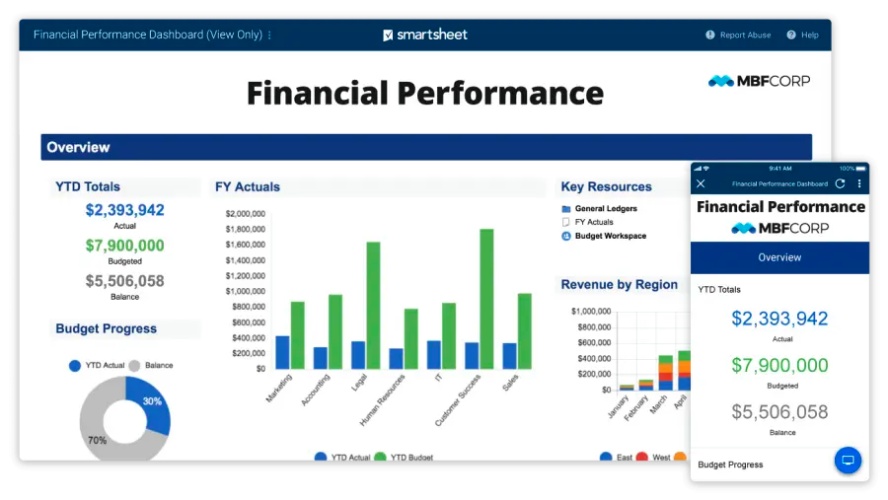
Smartsheet lets you quickly access program-related documents and links. (Source: Smartsheet)
- Analytics page: Visualize your team’s production and project status using Smartsheet’s robust analytics page. It pulls and displays data from team members, budget allocation, and time. Users can filter and group data into insightful reports.
- Conversations: Provide open channels for project communication using the conversations section. Use mentions, attach files, and send reminders to communicate efficiently and customize access levels per user.
- Document generation with e-signatures: Generate custom PDFs and send documents for signature within the Smartsheet platform. You can track signing statuses automatically within the sheets.
Airtable: Best for Data Tracking

What We Liked
- Up to 100,000 records per table
- Includes real-time collaboration and commenting
- Free plan comes with unlimited commenters and read-only users
Where It Falls Behind
- Only offers long-term annual billing
- Limited mobile functionality with a challenging interface
- Limited third-party integrations
Airtable Monthly Pricing (per User)
- Free: Free for unlimited bases, up to five creators or editors, unlimited commenters and readers, 1GB attachment space per base, and one sync integration
- Team: $24 for 50,000 records per base, 25,000 automation runs, unlimited editors per workspace, and 10GB attachment space
- Business: $54 for 125,000 records per base, 100,000 automation runs, 100GB attachments per base, and pure sync integrations
- Enterprise scale: Custom pricing for 500,000 records per base and automation runs, 1TB attachments per base, and enhanced security and admin controls
When it comes to connecting data and workflows, Airtable is the top choice because it gives users a unified platform to store company data. Give each user-specific data access, allowing them to perform their tasks while only accessing relevant information. Make better decisions by minimizing data silos and working with synced information across multiple systems in real time. Get unlimited workspaces with Airtable and store up to 250,000 records per database.
Unfortunately, Airtable isn’t suited for businesses seeking a resource planning tool with free and robust third-party integrations. Compared to other providers on this list offering hundreds of app integrations, Airtable only integrates with 34 applications. Consider Wrike because it offers 400-plus integrations. Connect Wrike with popular apps like Miro, Salesforce, and Microsoft OneDrive and give your team access to data and collated information across your business.
Airtable Features
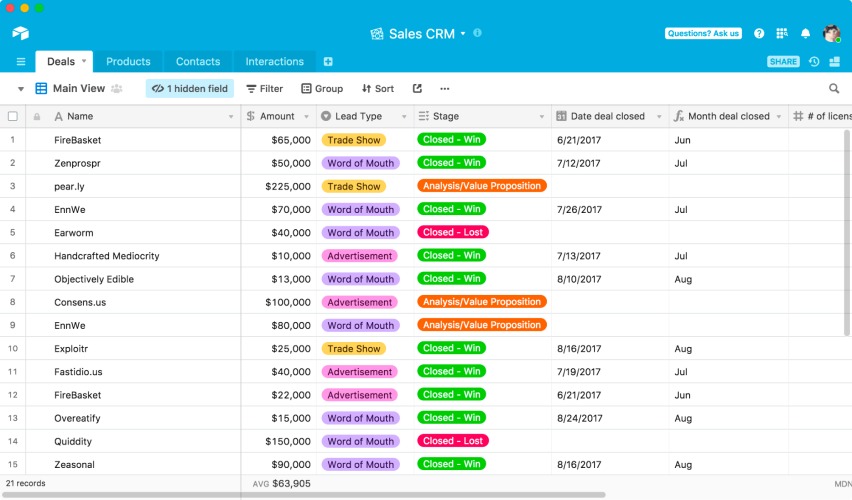
Use the group records feature to create Airtable reports. (Source Airtable)
- Reporting: Use native extensions to create custom reports and generate charts tailored to your team’s reporting needs. Turn data into a visual report using Airtable Extensions and highlight the most important information for different stakeholders and audiences.
- Custom branded forms: Collect information using custom forms that plug directly into your workflow. Choose which fields are visible, how they look, and the order they will be displayed.
- Read-only fields: Display and share an uneditable field on forms and give collaborators specific permissions that determine what they can and cannot edit in a base or workspace.
How We Evaluated the Best Free Resource Planning Software
We compiled a list of the top free resource planning tools offering essential features, ideal for small businesses on a budget. We created a rubric using relevant criteria, such as pricing, general and niche features, ease of use, customer support, and our expert rating. From there, we ranked the top platforms and chose the top five providers featured in this guide.
Learn how we evaluated the best free resource planning solution by clicking on the tabs below:
15% of Overall Score
To determine overall affordability for small to medium-sized businesses, we compared the pricing details of each resource planning software offering free plans. We gave higher points to providers charging less than $15 for the entry-level plan. We looked at feature inclusions and favored platforms with multiple plans, free trials, annual pricing, and volume-based discounts.
25% of Overall Score
We examined each provider’s general features, such as document management and task reminders. Since mobility and security are crucial to business operations, we prioritized solutions with two-factor authentication and available mobile applications.
20% of Overall Score
For niche features, we looked for providers with advanced view options like calendar and Gantt chart options and milestone tracking. Similarly, we awarded additional points if the platform supports expense management and integrations.
10% of Overall Score
Our assessment of each provider’s user-friendliness was determined through platform testing and checking user reviews from reliable websites. The evaluation also considered whether there is a learning curve to completing the setup and configuration process.
10% of Overall Score
The variety of available customer care communication channels formed part of our evaluation. We gave higher points to providers with phone, live chat, email, helpdesk, and community forums. Additional points are given if all support channels are available 24/7.
20% of Overall Score
We assessed each provider’s performance and overall quality by reviewing their standout features, value for money, and ease of use. We checked user ratings in third-party review sites to gauge the platform’s popularity.
Frequently Asked Questions (FAQs)
There are three common deployment options for ERP systems: cloud-based, on-premise, and hybrid ERP. Cloud-based ERP systems are remotely accessible on internet-connected devices, while on-premise ERP is software maintained within office premises. The third type, hybrid software, combines on-premise and cloud-based ERP system solutions, offering hosting and deployment services.
Resource planning software can be utilized in any industry for greater business efficiency and effective communications. These software systems are diverse and widely used across many industries, including manufacturing, healthcare and pharmaceuticals, hospitality, retail, and food and beverage. Resource planning software supports day-to-day business functions, such as human resources, financial accounting, and task management.
Resource planning software allows businesses to synchronize human capital and organizational schedules into a single platform for better project management. On the other hand, CRM automates customer interactions and insights. Both are business applications used to store and analyze data.
Bottom Line
Resource planning software is crucial to determining resource capacity and utilization and forecasting future availability. Small businesses benefit from resource planning solutions because it enables managers to plan time, money, and assets efficiently. The best platforms have scheduling, time entry, and real-time reporting capabilities.
Upon review of the most popular resource planning software, monday.com is the best option because of its versatile, scalable, and task-tracking capabilities. This platform offers multiple board views, customizable reporting, and real-time communication, including mentions and notifications. Sign up for monday.com’s 14-day free trial to see if it fits your business well.